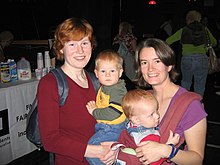
Heterosexuality is romantic attraction, sexual attraction or sexual behavior between people of the opposite sex or gender. As a sexual orientation, heterosexuality is "an enduring pattern of emotional, romantic, and/or sexual attractions" to people of the opposite sex; it "also refers to a person's sense of identity based on those attractions, related behaviors, and membership in a community of others who share those attractions." Someone who is heterosexual is commonly referred to as straight.

Sexual orientation is an enduring personal pattern of romantic attraction or sexual attraction to persons of the opposite sex or gender, the same sex or gender, or to both sexes or more than one gender. Patterns are generally categorized under heterosexuality, homosexuality, and bisexuality, while asexuality is sometimes identified as the fourth category.
Baker v. Vermont, 744 A.2d 864, was a lawsuit decided by Vermont Supreme Court on December 20, 1999. It was one of the first judicial affirmations of the right of same-sex couples to treatment equivalent to that afforded different-sex couples. The decision held that the state's prohibition on same-sex marriage denied rights granted by the Vermont Constitution. The court ordered the Vermont legislature to either allow same-sex marriages or implement an alternative legal mechanism according similar rights to same-sex couples.
Same-sex marriage, also known as gay marriage, is the marriage of two people of the same legal sex. As of 2024, marriage between same-sex couples is legally performed and recognized in 36 countries, with a total population of 1.3 billion people. The most recent country to legalise same-sex marriage is Greece.
Heteronormativity is the concept that heterosexuality is the preferred or normal sexual orientation. It assumes the gender binary and that sexual and marital relations are most fitting between people of opposite sex.

The availability of legally recognized same-sex marriage in the United States expanded from one state (Massachusetts) in 2004 to all fifty states in 2015 through various court rulings, state legislation, and direct popular votes. States each have separate marriage laws, which must adhere to rulings by the Supreme Court of the United States that recognize marriage as a fundamental right guaranteed by both the Due Process Clause and the Equal Protection Clause of the Fourteenth Amendment to the United States Constitution, as first established in the 1967 landmark civil rights case of Loving v. Virginia.

The field of psychology has extensively studied homosexuality as a human sexual orientation. The American Psychiatric Association listed homosexuality in the DSM-I in 1952, but that classification came under scrutiny in research funded by the National Institute of Mental Health. That research and subsequent studies consistently failed to produce any empirical or scientific basis for regarding homosexuality as anything other than a natural and normal sexual orientation that is a healthy and positive expression of human sexuality. As a result of this scientific research, the American Psychiatric Association removed homosexuality from the DSM-II in 1973. Upon a thorough review of the scientific data, the American Psychological Association followed in 1975 and also called on all mental health professionals to take the lead in "removing the stigma of mental illness that has long been associated" with homosexuality. In 1993, the National Association of Social Workers adopted the same position as the American Psychiatric Association and the American Psychological Association, in recognition of scientific evidence. The World Health Organization, which listed homosexuality in the ICD-9 in 1977, removed homosexuality from the ICD-10 which was endorsed by the 43rd World Health Assembly on 17 May 1990.

Goodridge v. Dept. of Public Health, 798 N.E.2d 941, is a landmark Massachusetts Supreme Judicial Court case in which the Court held that the Massachusetts Constitution requires the state to legally recognize same-sex marriage. The November 18, 2003, decision was the first by a U.S. state's highest court to find that same-sex couples had the right to marry. Despite numerous attempts to delay the ruling, and to reverse it, the first marriage licenses were issued to same-sex couples on May 17, 2004, and the ruling has been in full effect since that date.
Same-sex adoption is the adoption of children by same-sex couples. It may take the form of a joint adoption by the couple, or of the adoption by one partner of the other's biological child.

Homosexuality is a sexual attraction, romantic attraction, or sexual behavior between members of the same sex or gender. As a sexual orientation, homosexuality is "an enduring pattern of emotional, romantic, and/or sexual attractions" exclusively to people of the same sex or gender. It "also refers to a person's sense of identity based on those attractions, related behaviors, and membership in a community of others who share those attractions."

Same-sex parenting is the parenting of children by same-sex couples generally consisting of gays or lesbians who are often in civil partnerships, domestic partnerships, civil unions, or same-sex marriages.
The extension of civil marriage, union, and domestic partnership rights to same-sex couples in various jurisdictions can raise legal issues upon dissolution of these unions that are not experienced by opposite-sex couples, especially if law of their residence or nationality does not have same-sex marriage or partnerships.

A same-sex relationship is a romantic or sexual relationship between people of the same sex. Same-sex marriage refers to the institutionalized recognition of such relationships in the form of a marriage; civil unions may exist in countries where same-sex marriage does not.
Homosexuality, as a phenomenon and as a behavior, has existed throughout all eras in human societies.
Citizens for Equal Protection v. Bruning, 455 F.3d 859, was a federal lawsuit filed in the United States District Court for the District of Nebraska and decided on appeal by the United States Court of Appeals for the Eighth Circuit. It challenged the federal constitutionality of Nebraska Initiative Measure 416, a 2000 ballot initiative that amended the Nebraska Constitution to prohibit the recognition of same-sex marriages, civil unions, and other same-sex relationships.
Law in Australia with regard to children is often based on what is considered to be in the best interest of the child. The traditional and often used assumption is that children need both a mother and a father, which plays an important role in divorce and custodial proceedings, and has carried over into adoption and fertility procedures. As of April 2018 all Australian states and territories allow adoption by same-sex couples.
Until 2017, laws related to LGBTQ+ couples adopting children varied by state. Some states granted full adoption rights to same-sex couples, while others banned same-sex adoption or only allowed one partner in a same-sex relationship to adopt the biological child of the other. Despite these rulings, same-sex couples and members of the LGBTQ+ community still face discrimination when attempting to foster children.
Mark Daniel Regnerus is a sociologist and professor at the University of Texas at Austin. His main fields of interest are sexual behavior, relationship dynamics, and religion.
The New Family Structures Study is a sociological study of LGBT parenting conducted by sociologist Mark Regnerus of the University of Texas at Austin. The study surveyed over 15,000 Americans of ages 18 to 39. The first research article based on data from the study was published in July 2012 in Social Science Research, and concluded that people who had had a parent who had been in a same-gender relationship were at a greater risk of several adverse outcomes, including "being on public assistance, being unemployed, and having poorer educational attainment."
DeBoer v. Snyder is a lawsuit that was filed by April DeBoer and Jayne Rowse on January 23, 2012, in federal district court, challenging Michigan's ban on adoption by same-sex couples so they can jointly adopt their children. In August 2012, Judge Bernard A. Friedman invited the couple to amend their suit to challenge the state's ban on same-sex marriage, "the underlying issue". Following a hearing on October 16, 2013, Friedman scheduled a trial that ran from February 25 to March 7, 2014. On March 21, Judge Friedman issued his ruling overturning the ban. On March 22, the United States Court of Appeals for the Sixth Circuit placed a temporary hold on Judge Friedman's ruling. The appeal was argued on August 6. On November 6, the Sixth Circuit reversed Judge Friedman and upheld Michigan's ban on same-sex marriage.





